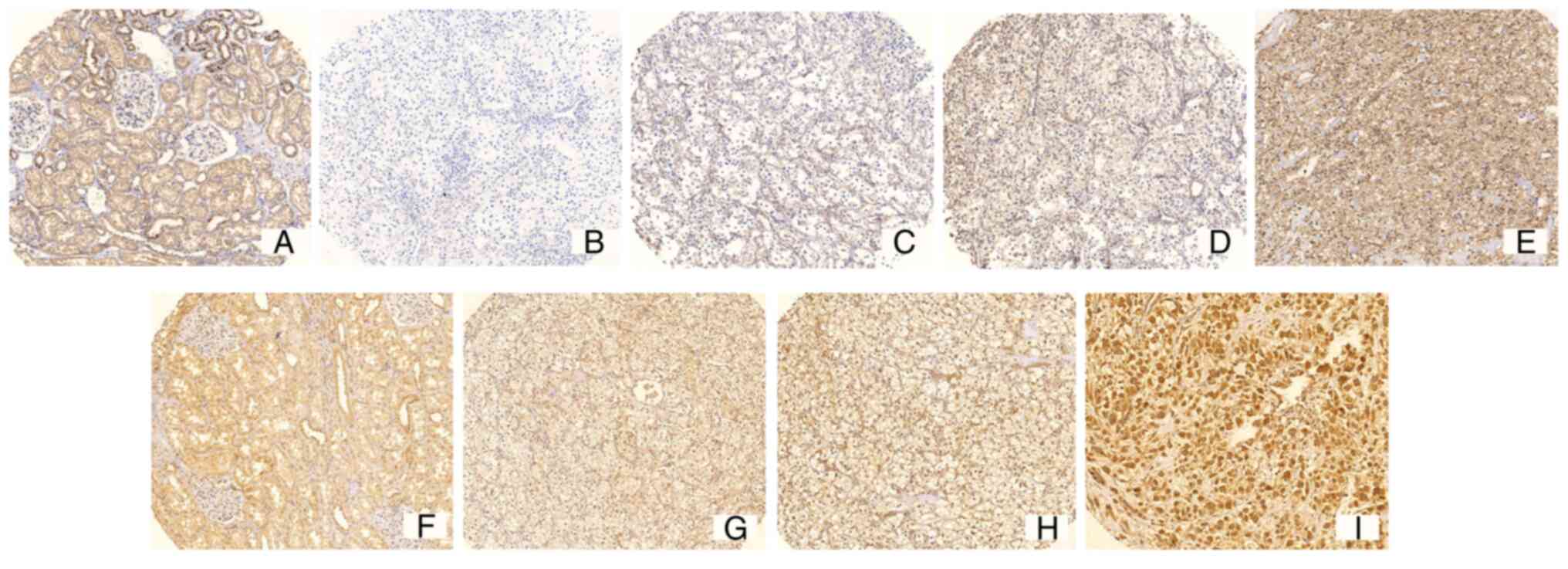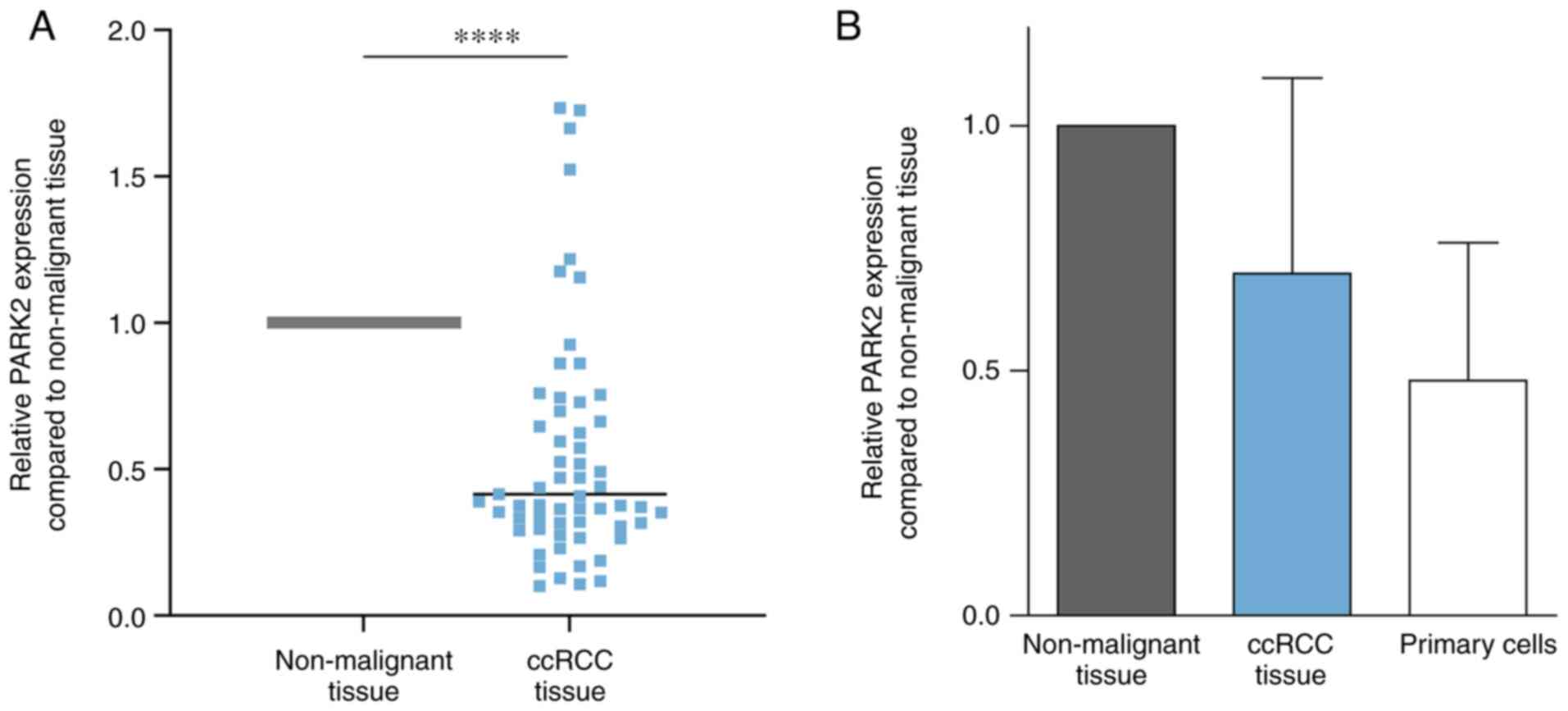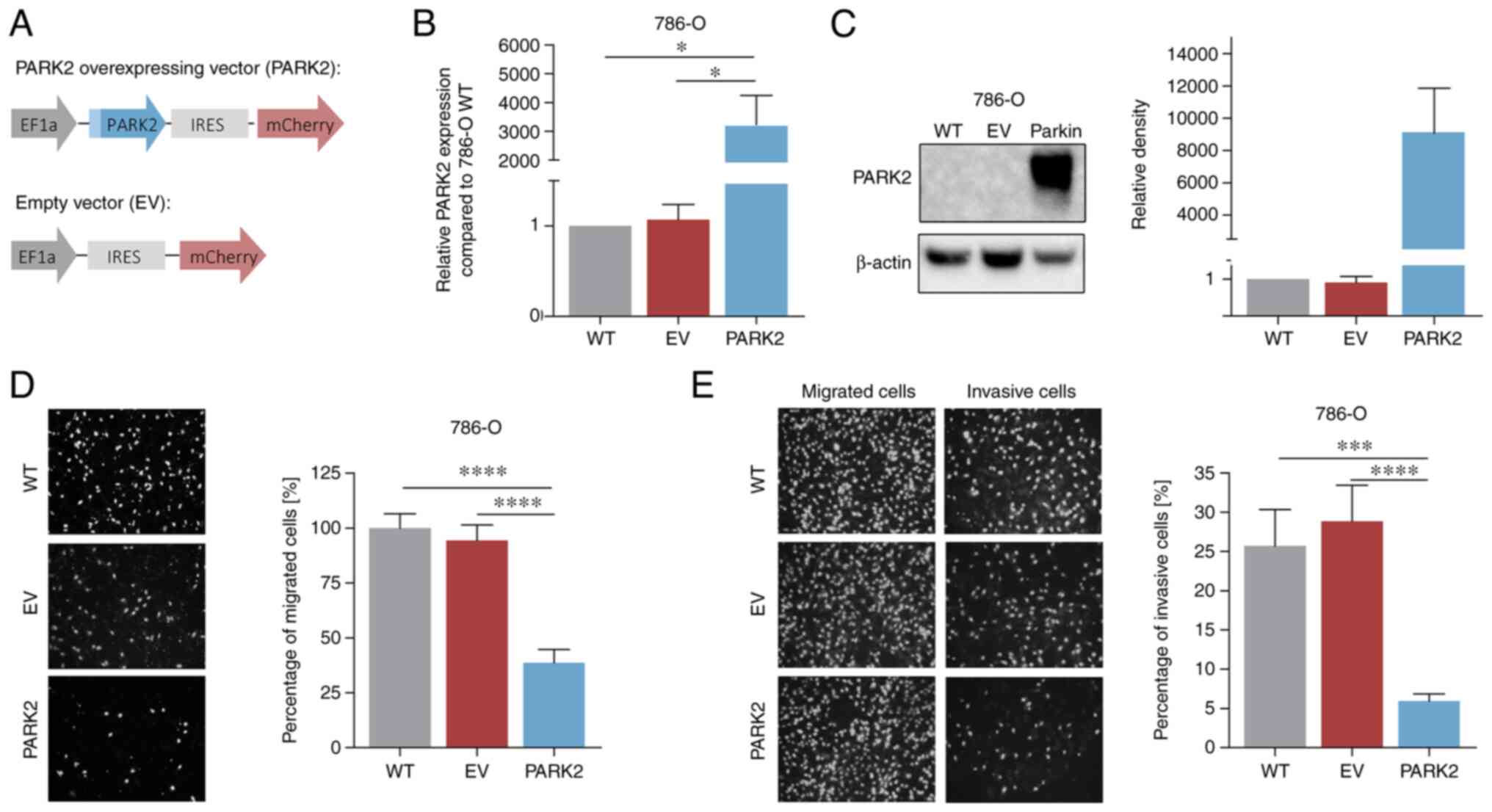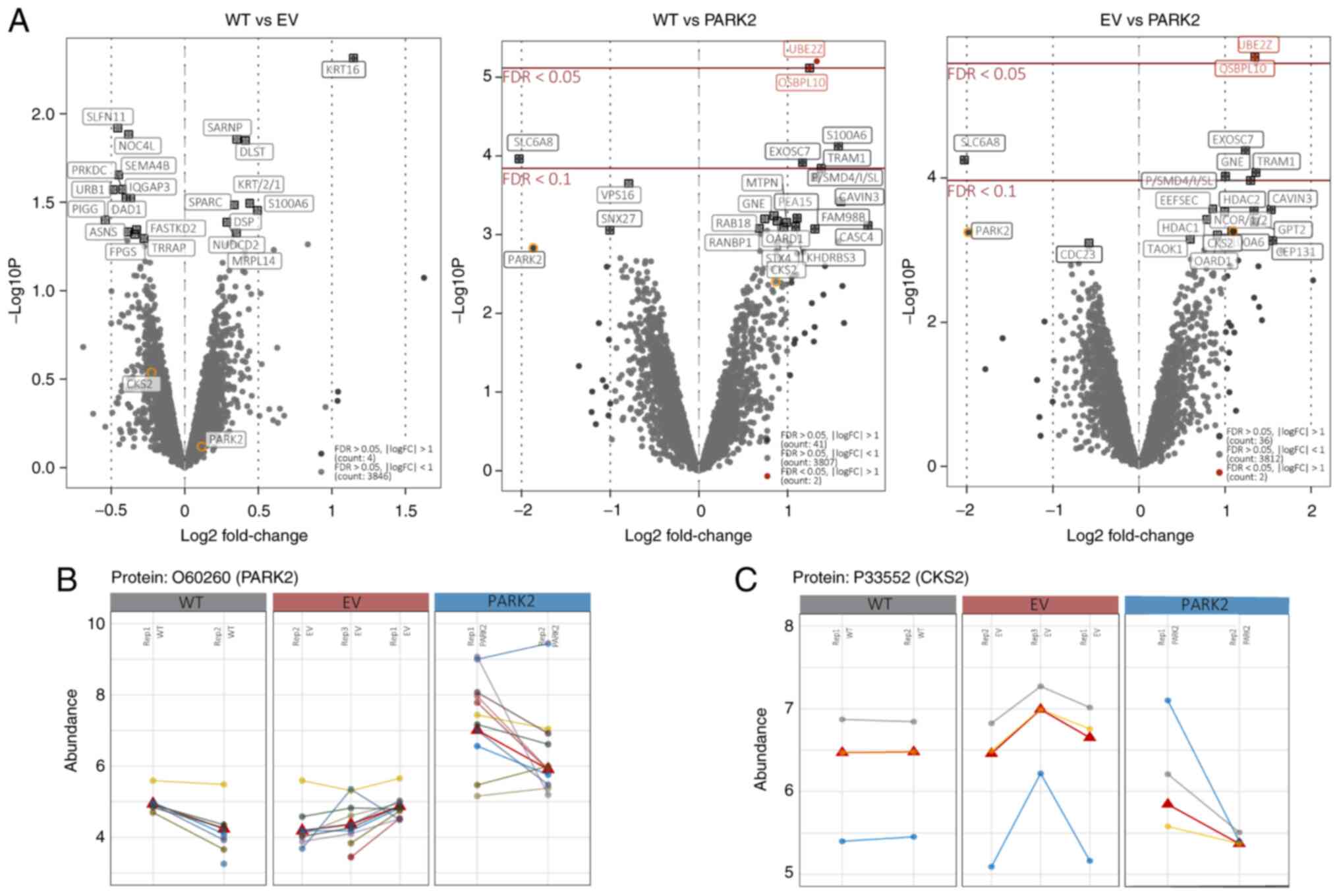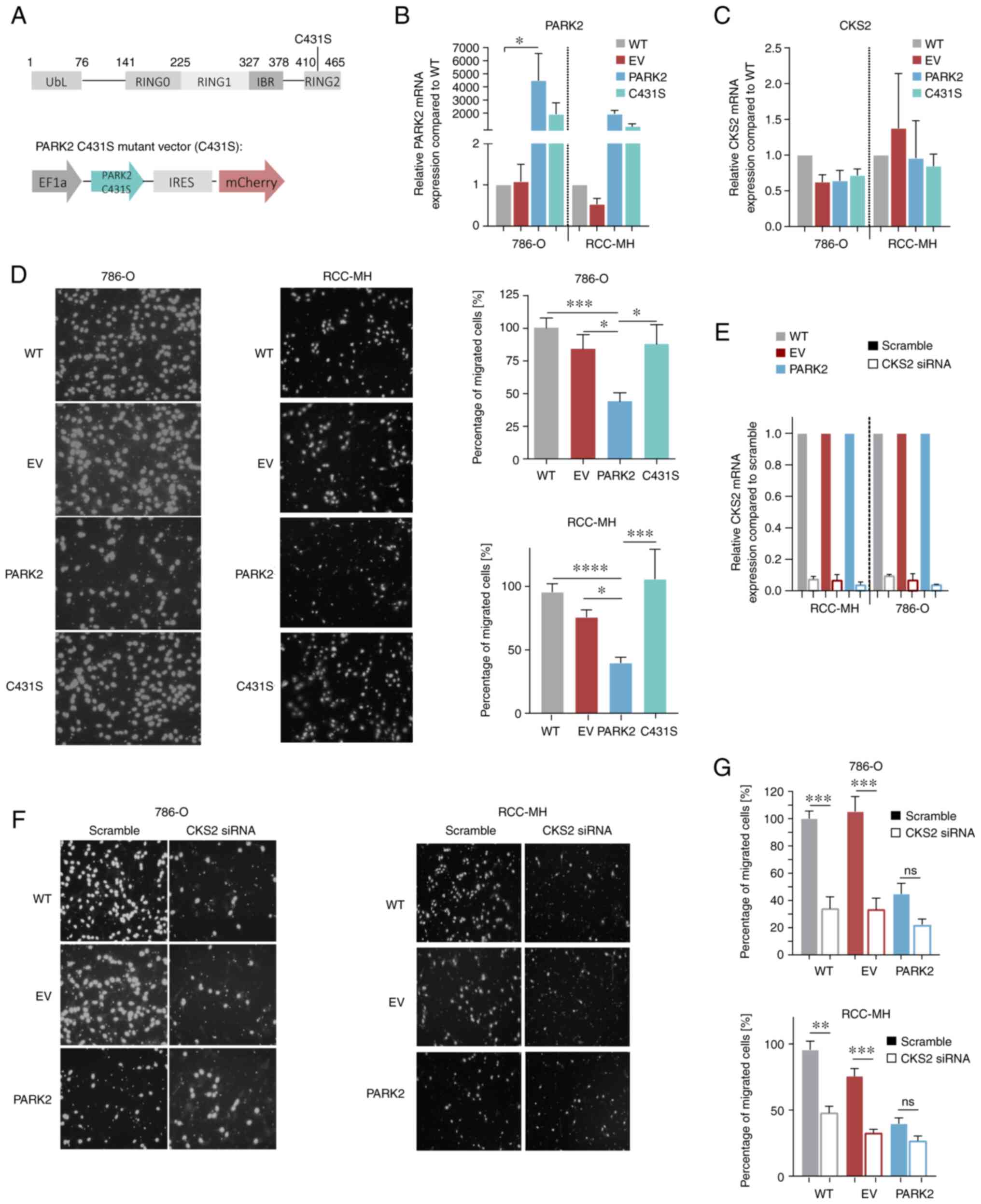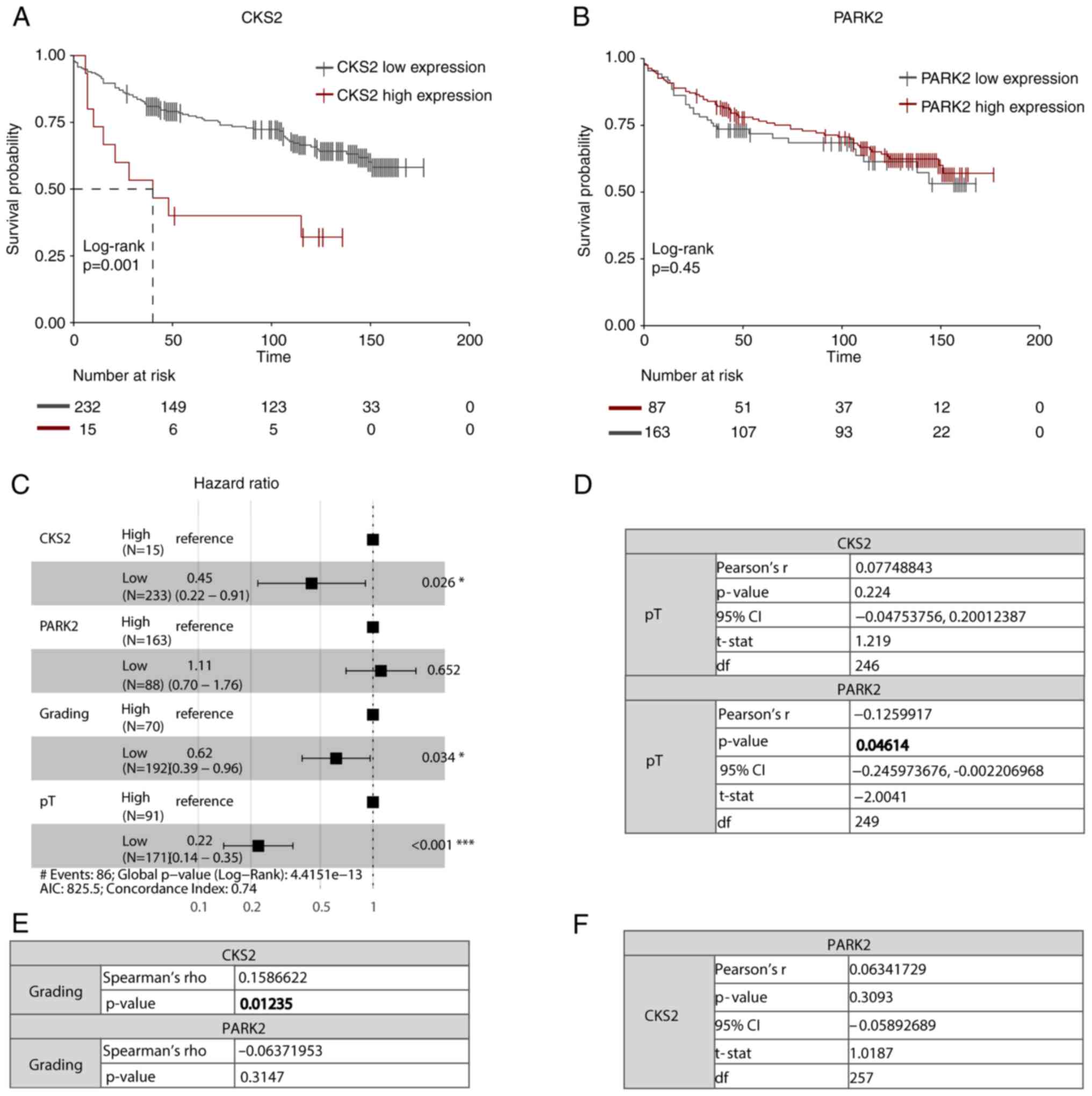|
1
|
Ferlay J, Ervik M, Lam F, Colombet M, Mery
L, Piñeros M, Znaor A, Soerjomataram I and Bray F: Global cancer
observatory: Cancer today. IARC; Lyon: 2020
|
|
2
|
SEER*Explorer: An interactive website for
SEER cancer statistics (Internet). Surveillance Research Program,
National Cancer Institute; Bethesda, MD: 2021, https://seer.cancer.gov/explorer/. Accessed
September 27, 2021.
|
|
3
|
American Society of Clinical Oncology
(ASCO): Kidney cancer. ASCO; Alexandria, VA: 2021
|
|
4
|
Padala SA and Barsouk A, Thandra KC,
Saginala K, Mohammed A, Vakiti A, Rawla P and Barsouk A:
Epidemiology of renal cell carcinoma. World J Oncol. 11:79–87.
2020. View Article : Google Scholar : PubMed/NCBI
|
|
5
|
Toma MI, Wuttig D, Kaiser S, Herr A, Weber
T, Zastrow S, Koch R, Meinhardt M, Baretton GB, Wirth MP and
Fuessel S: PARK2 and PACRG are commonly downregulated in clear-cell
renal cell carcinoma and are associated with aggressive disease and
poor clinical outcome. Genes Chromosomes Cancer. 52:265–273. 2013.
View Article : Google Scholar
|
|
6
|
Poulogiannis G, McIntyre RE, Dimitriadi M,
Apps JR, Wilson CH, Ichimura K, Luo F, Cantley LC, Wyllie AH, Adams
DJ and Arends MJ: PARK2 deletions occur frequently in sporadic
colorectal cancer and accelerate adenoma development in Apc mutant
mice. Proc Natl Acad Sci USA. 107:15145–15150. 2010. View Article : Google Scholar : PubMed/NCBI
|
|
7
|
Kitada T, Asakawa S, Hattori N, Matsumine
H, Yamamura Y, Minoshima S, Yokochi M, Mizuno Y and Shimizu N:
Mutations in the parkin gene cause autosomal recessive juvenile
parkinsonism. Nature. 392:605–608. 1998. View Article : Google Scholar
|
|
8
|
Ikeuchi K, Marusawa H, Fujiwara M,
Matsumoto Y, Endo Y, Watanabe T, Iwai A, Sakai Y, Takahashi R and
Chiba T: Attenuation of proteolysis-mediated cyclin E regulation by
alternatively spliced parkin in human colorectal cancers. Int J
Cancer. 125:2029–2035. 2009. View Article : Google Scholar : PubMed/NCBI
|
|
9
|
Wang H, Liu B, Zhang C, Peng G, Liu M, Li
D, Gu F, Chen Q, Dong JT, Fu L and Zhou J: Parkin regulates
paclitaxel sensitivity in breast cancer via a microtubule-dependent
mechanism. J Pathol. 218:76–85. 2009. View Article : Google Scholar : PubMed/NCBI
|
|
10
|
Liu J, Zhang C, Zhao Y, Yue X, Wu H, Huang
S, Chen J, Tomsky K, Xie H, Khella CA, et al: Parkin targets HIF-1α
for ubiquitination and degradation to inhibit breast tumor
progression. Nat Commun. 8:18232017. View Article : Google Scholar
|
|
11
|
Liu K, Li F, Han H, Chen Y, Mao Z, Luo J,
Zhao Y, Zheng B, Gu W and Zhao W: Parkin regulates the activity of
Pyruvate Kinase M2. J Biol Chem. 291:10307–10317. 2016. View Article : Google Scholar : PubMed/NCBI
|
|
12
|
Bernardini JP, Lazarou M and Dewson G:
Parkin and mitophagy in cancer. Oncogene. 36:1315–1327. 2017.
View Article : Google Scholar
|
|
13
|
Liu J, Zhang C, Hu W and Feng Z:
Parkinson's disease-associated protein Parkin: An unusual player in
cancer. Cancer Communications. 38:402018. View Article : Google Scholar : PubMed/NCBI
|
|
14
|
Shimura H, Hattori N, Kubo Si, Mizuno Y,
Asakawa S, Minoshima S, Shimizu N, Iwai K, Chiba T, Tanaka K and
Suzuki T: Familial Parkinson disease gene product, parkin, is a
ubiquitin-protein ligase. Nat Genet. 25:302–305. 2000. View Article : Google Scholar
|
|
15
|
Simon AG, Esser LK, Ellinger J, Branchi V,
Tolkach Y, Müller S, Ritter M, Kristiansen G, Muders MH, Mayr T and
Toma MI: Targeting glycolysis with 2-deoxy-D-glucose sensitizes
primary cell cultures of renal cell carcinoma to tyrosine kinase
inhibitors. J Cancer Res Clin Oncol. 146:2255–2265. 2020.
View Article : Google Scholar : PubMed/NCBI
|
|
16
|
Livak KJ and Schmittgen TD: Analysis of
relative gene expression data using real-time quantitative PCR and
the 2(-Delta Delta C(T)) method. Methods. 25:402–408. 2001.
View Article : Google Scholar
|
|
17
|
Kim D, Paggi JM, Park C, Bennett C and
Salzberg SL: Graph-based genome alignment and genotyping with
HISAT2 and HISAT-genotype. Nat Biotechnol. 37:907–915. 2019.
View Article : Google Scholar : PubMed/NCBI
|
|
18
|
Li H, Handsaker B, Wysoker A, Fennell T,
Ruan J, Homer N, Marth G, Abecasis G and Durbin R; 1000 Genome
Project Data Processing Subgroup: The sequence alignment/map format
and SAMtools. Bioinformatics. 25:2078–2079. 2009. View Article : Google Scholar : PubMed/NCBI
|
|
19
|
Liao Y, Smyth GK and Shi W: featureCounts:
An efficient general purpose program for assigning sequence reads
to genomic features. Bioinformatics. 30:923–930. 2014. View Article : Google Scholar
|
|
20
|
R Core Team: R: A language and environment
for statistical computing. R Foundation for Statistical Computing;
Vienna: 2021, https://www.R-project.org/.
|
|
21
|
Love MI, Huber W and Anders S: Moderated
estimation of fold change and dispersion for RNA-seq data with
DESeq2. Genome Biology. 15:5502014. View Article : Google Scholar : PubMed/NCBI
|
|
22
|
Zhu A, Ibrahim JG and Love MI:
Heavy-tailed prior distributions for sequence count data: Removing
the noise and preserving large differences. Bioinformatics.
35:2084–2092. 2019. View Article : Google Scholar :
|
|
23
|
Wickham H: ggplot2: Elegant graphics for
data analysis. 2nd edition. Springer; Cham: 2016, View Article : Google Scholar
|
|
24
|
León IR, Schwämmle V, Jensen ON and
Sprenger RR: Quantitative assessment of in-solution digestion
efficiency identifies optimal protocols for unbiased protein
analysis. Mol Cell Proteomics. 12:2992–3005. 2013. View Article : Google Scholar : PubMed/NCBI
|
|
25
|
Masuda T, Tomita M and Ishihama Y: Phase
transfer surfactant-aided trypsin digestion for membrane proteome
analysis. J Proteome Res. 7:731–740. 2008. View Article : Google Scholar
|
|
26
|
Manza LL, Stamer SL, Ham A-JL, Codreanu SG
and Liebler DC: Sample preparation and digestion for proteomic
analyses using spin filters. Proteomics. 5:1742–1745. 2005.
View Article : Google Scholar : PubMed/NCBI
|
|
27
|
Wiśniewski JR, Zougman A, Nagaraj N and
Mann M: Universal sample preparation method for proteome analysis.
Nat Methods. 6:359–362. 2009. View Article : Google Scholar
|
|
28
|
Huber W, von Heydebreck A, Sueltmann H,
Poustka A and Vingron M: Variance stabilization applied to
microarray data calibration and to the quantification of
differential expression. Bioinformatics. 18(Suppl 1): S96–S104.
2002. View Article : Google Scholar : PubMed/NCBI
|
|
29
|
Ritchie ME, Phipson B, Wu D, Law CW, Shi W
and Smyth GK: limma powers differential expression analyses for
RNA-sequencing and microarray studies. Nucleic Acids Res.
43:e472015. View Article : Google Scholar :
|
|
30
|
Kassambara A, Kosinski M, Biecek P and
Fabian S: Drawing Survival Curves using 'ggplot2'. https://cran.r-project.org/web/packages/survminer/index.html.
Accessed March 9, 2021.
|
|
31
|
Ni H, Zhou Z, Jiang B, Yuan X, Cao X,
Huang G and Li Y: Inactivation of parkin by promoter methylation
correlated with lymph node metastasis and genomic instability in
nasopharyngeal carcinoma. Tumour Biol. 39:1010428317695022017.
View Article : Google Scholar
|
|
32
|
Huang N, Wu Z, Hong H, Wang X, Yang F and
Li H: Overexpression of CKS2 is associated with a poor prognosis
and promotes cell proliferation and invasion in breast cancer. Mol
Med Rep. 19:4761–4769. 2019.PubMed/NCBI
|
|
33
|
Xu JH, Wang Y and Xu D: CKS2 promotes
tumor progression and metastasis and is an independent predictor of
poor prognosis in epithelial ovarian cancer. Eur Rev Med Pharmacol
Sci. 23:3225–3234. 2019.
|
|
34
|
Yu MH, Luo Y, Qin SL, Wang ZS, Mu YF and
Zhong M: Up-regulated CKS2 promotes tumor progression and predicts
a poor prognosis in human colorectal cancer. Am J Cancer Res.
5:2708–2718. 2015.PubMed/NCBI
|
|
35
|
Riley BE, Lougheed JC, Callaway K,
Velasquez M, Brecht E, Nguyen L, Shaler T, Walker D, Yang Y,
Regnstrom K, et al: Structure and function of parkin E3 ubiquitin
ligase reveals aspects of RING and HECT ligases. Nat Commun.
4:19822013. View Article : Google Scholar : PubMed/NCBI
|
|
36
|
Singh K, Han K, Tilve S, Wu K, Geller HM
and Sack MN: Parkin targets NOD2 to regulate astrocyte endoplasmic
reticulum stress and inflammation. Glia. 66:2427–2437. 2018.
View Article : Google Scholar :
|
|
37
|
Wenzel DM, Lissounov A, Brzovic PS and
Klevit RE: UBCH7 reactivity profile reveals parkin and HHARI to be
RING/HECT hybrids. Nature. 474:105–108. 2011. View Article : Google Scholar
|
|
38
|
Xu L, Lin D, Yin D and Koeffler HP: An
emerging role of PARK2 in cancer. J Mol Med. 92:31–42. 2014.
View Article : Google Scholar
|
|
39
|
Duan H, Lei Z, Xu F, Pan T, Lu D, Ding P,
Zhu C, Pan C and Zhang S: PARK2 suppresses proliferation and
tumorigenicity in non-small cell lung cancer. Front Oncol.
9:7902019. View Article : Google Scholar : PubMed/NCBI
|
|
40
|
Lee YS, Jung YY, Park MH, Yeo IJ, Im HS,
Nam KT, Kim HD, Kang SK, Song JK, Kim YR, et al: Deficiency of
parkin suppresses melanoma tumor development and metastasis through
inhibition of MFN2 ubiquitination. Cancer Lett. 433:156–164. 2018.
View Article : Google Scholar : PubMed/NCBI
|
|
41
|
Uhlen M, Zhang C, Lee S, Sjöstedt E,
Fagerberg L, Bidkhori G, Benfeitas R, Arif M, Liu Z, Edfors F, et
al: A pathology atlas of the human cancer transcriptome. Science.
357:eaan25072017. View Article : Google Scholar : PubMed/NCBI
|
|
42
|
Kakarougkas A, Ismail A, Chambers AL,
Riballo E, Herbert AD, Künzel J, Löbrich M, Jeggo PA and Downs JA:
Requirement for PBAF in transcriptional repression and repair at
DNA breaks in actively transcribed regions of chromatin. Mol Cell.
55:723–732. 2014. View Article : Google Scholar :
|
|
43
|
Jonsson M, Fjeldbo CS, Holm R, Stokke T,
Kristensen GB and Lyng H: Mitochondrial function of CKS2
oncoprotein links oxidative phosphorylation with cell division in
chemoradioresistant cervical cancer. Neoplasia. 21:353–362. 2019.
View Article : Google Scholar :
|
|
44
|
Durcan TM and Fon EA: The three 'P's of
mitophagy: PARKIN, PINK1, and post-translational modifications.
Genes Dev. 29:989–999. 2015. View Article : Google Scholar :
|
|
45
|
Tanaka F, Matsuzaki S, Mimori K, Kita Y,
Inoue H and Mori M: Clinicopathological and biological significance
of CDC28 protein kinase regulatory subunit 2 overexpression in
human gastric cancer. Int J Oncol. 39:361–372. 2011.
|
|
46
|
Shen DY, Zhan YH, Wang QM, Rui G and Zhang
ZM: Oncogenic potential of cyclin kinase subunit-2 in
cholangiocarcinoma. Liver Int. 33:137–148. 2013. View Article : Google Scholar
|
|
47
|
Hua K, Jin J, Zhang H, Zhao B, Wu C, Xu H
and Fang L: MicroRNA-7 inhibits proliferation, migration and
invasion of thyroid papillary cancer cells via targeting CKS2. Int
J Oncol. 49:1531–1540. 2016. View Article : Google Scholar : PubMed/NCBI
|
|
48
|
Lan Y, Zhang Y, Wang J, Lin C, Ittmann MM
and Wang F: Aberrant expression of Cks1 and Cks2 contributes to
prostate tumorigenesis by promoting proliferation and inhibiting
programmed cell death. Int J Cancer. 123:543–551. 2008. View Article : Google Scholar : PubMed/NCBI
|
|
49
|
You H, Lin H and Zhang Z: CKS2 in human
cancers: Clinical roles and current perspectives (Review). Mol Clin
Oncol. 3:459–463. 2015. View Article : Google Scholar : PubMed/NCBI
|
|
50
|
Trempe JF, Sauvé V, Grenier K, Seirafi M,
Tang MY, Ménade M, Al-Abdul-Wahid S, Krett J, Wong K, Kozlov G, et
al: Structure of parkin reveals mechanisms for ubiquitin ligase
activation. Science. 340:1451–1455. 2013. View Article : Google Scholar
|
|
51
|
Perez-Riverol Y, Csordas A, Bai J,
Bernal-Llinares M, Hewapathirana S, Kundu DJ, Inuganti A, Griss J,
Mayer G, Eisenacher M, et al: The PRIDE database and related tools
and resources in 2019: Improving support for quantification data.
Nucleic Acids Res. 47:D442–D450. 2019. View Article : Google Scholar :
|















